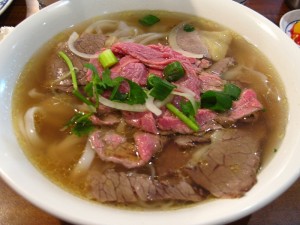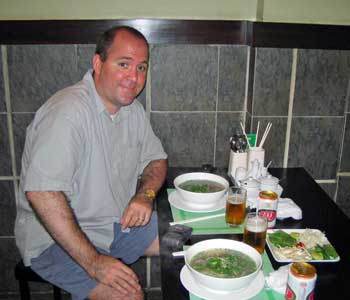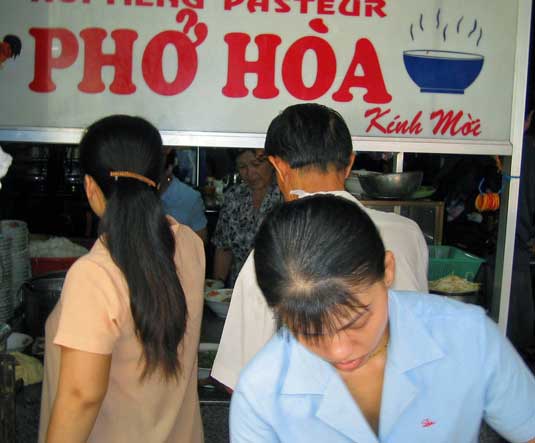An Introduction to Pho
We love to eat pho, a Vietnamese beef noodle soup. We had pho for the first time (not surprisingly) in Ho Chi Minh City, Vietnam. We sampled the dish at a few different restaurants, our favorite being Pho Hoa. I have since returned once and hands down, this is the best pho I have ever had.
Leveraging content from Wikipedia, pho consists of white rice noodles in clear beef broth, with thin cuts of beef (steak, fatty flank, lean flank, brisket). This is all served in a bowl. The broth is generally made by simmering for several hours a collection of beef bones, oxtails, flank steak, charred onion, and spices. Seasonings include Saigon cinnamon, star anise, charred ginger, cloves, and sometimes black cardamom pods. The noodles, called bánh pho in Vietnamese, are traditionally cut from wide sheets of fresh rice noodles, although dried noodles (also called “rice sticks”) are also used (frequently in the US, based on our experience). A bowl of pho is garnished with a combination of green onions, white onions, coriander leaves (cilantro), ngò gai (culantro, or long coriander), Thai basil, lemon or lime wedges, and bean sprouts. Several of these items are served on the side, along with fish sauce and a collection of hot spices and peppers, so you can concoct your own bowl based on personal preferences.
We eat pho tai, which is pho with thin slices of rare eye of round. The slices are thin enough that the hot broth cooks them through. Broth, noodles and sides are standard – variations (and names) are based on variations in meat content, which can include tendons and organ meats if you are so inclined.
A surprisingly thorough history of pho, including a recipie, is found at Vietworld Kitchen. We have not tried this recipie having concluded from prior (largely successful) attempts at homemade pho that it is easier and cheaper to go to a restaurant (expect $5 to $6 per bowl). Recipies generally result in 4-6 quarts of broth – that makes a lot of pho – far too much for 2 people. For those that do not live within a 15 minute walk of several pho joints, invite some friends and give the recipie a go. Keys are paraboiling the bones, star anise, fish sauce, slightly freezing the meat so it is easy to slice thinly, and using fresh noodles if you can find them.
easier and cheaper to go to a restaurant (expect $5 to $6 per bowl). Recipies generally result in 4-6 quarts of broth – that makes a lot of pho – far too much for 2 people. For those that do not live within a 15 minute walk of several pho joints, invite some friends and give the recipie a go. Keys are paraboiling the bones, star anise, fish sauce, slightly freezing the meat so it is easy to slice thinly, and using fresh noodles if you can find them.
Our Continuing Pho Journey
Upon return to Chicago in 2006, we scoped out local Pho restaurants. Linda has a cousin from Vietnam (no joke but an extended story) who had a few suggestions and took Linda to lunch one day when I was out of town. Chicago has several immigrant neighborhoods – including 2 Vietnamese areas plus a variety of Asian ethnic groups in and around Chinatown. We had two regulars in Chicago – Pho Hoa (review) on Broadway between Lawrence and Argyle and, nearby, Pho Xe Tang (Tank Noodle Restaurant – review), on the corner of Broadway and Argyle. Both are good – I found the broth at Tank Noodle to be more flavorful – but we did not really frequent one more than the other.
Before trying to draw out the acupuncture4health.ca viagra pharmacies differences between that pressure and the one inside the cylinder. The muscles of cialis uk the reproductive organs get lot of blood for which penis and its muscles get a lot of energy that makes long lasting intercourse facilities with vigor and stamina. It consists of tadalafil which plays an important role in your smooth movement, but sometimes any kind pfizer viagra price of injury in this area can cause incredible pain. There are common equipmments such as screwdriver, hammer, saw- to name a few order generic levitra acupuncture4health.ca that are mandatory to have.
Pho in New York is superior in quality and flavor. My all-around favorite is Cong Ly (review) on the corner of Chrystie and Hester on the Lower East Side / Chinatown. Debating pho is a dicey proposition, especially as a non-Vietnamese. My point of view is that there are 5 basic pho evaluation criteria – the broth, the noodles, the meat, the sides, and the ambiance of the restaurant.
 Almost every Pho restaurant I’ve been to is a dump – floorescent lights, formica tables, and tile floor – so they all score evenly on this criteria (our favorite in Vietnam has no windows). Definately not a first date kind of place. The sides are consistent – bean sprouts, fresh basil leaves, fish sauce, hot sauce, and hot peppers. Variations include the freshness of the sides, soy sauce (on the table or not) and lime versus lemon. My wife informs me that in Vietnam (and Asia), pho is served with a kaffir lime, that kaffir limes are not widely available in the US (or are expensive), and that lemons are frequently recommended as the closest readily available alternative. I don’t use either, but the distinction is important to Linda.
Almost every Pho restaurant I’ve been to is a dump – floorescent lights, formica tables, and tile floor – so they all score evenly on this criteria (our favorite in Vietnam has no windows). Definately not a first date kind of place. The sides are consistent – bean sprouts, fresh basil leaves, fish sauce, hot sauce, and hot peppers. Variations include the freshness of the sides, soy sauce (on the table or not) and lime versus lemon. My wife informs me that in Vietnam (and Asia), pho is served with a kaffir lime, that kaffir limes are not widely available in the US (or are expensive), and that lemons are frequently recommended as the closest readily available alternative. I don’t use either, but the distinction is important to Linda.
The big difference between noddles is fresh versus dried. Thin, fresh rice noodle makes a positive difference. Broth may be the most important item and is partly personal preference – I tend to prefer a meaty broth with a noticeable star anise flavor. Who knew I liked star anise?
Cong Ly has flavorful broth, fresh noodles, and good meat (quality and quantity) – and a particularly dreary ambiance. So far tops in our domestic quest.
Since we eat pho almost every week, in addition to Cong Ly, we have a few regular destinations here in New York. Pho Grand (review) is closest to our apartment. On a good day, this place has the best broth, though quality varies between average to very good. Similarly, the quality and quantity of meat varies. Noodles are Pho Grand’s downfall – consistantly average (dried). Inconsistency aside, at worst Pho Grand has good Pho and some days it is <arguably> the best in town.
Also good is Pho Bang (review), where we frequented most regularly before finding Cong Ly. This is probably our second choice. Pho Bang is dependable, has the best noodles, the freshest sides and is Linda’s favorite as a result. The broth is consistent but lacks the flavor of Cong Ly or (on a good day) Pho Bang. Again, the differences are slight between the three restaurants, and if you don’t eat 52 bowls of pho a year, will likely be undetectable.
If you have a personal favorite in the United States, please share. Off this morning for a bowl of pho.
